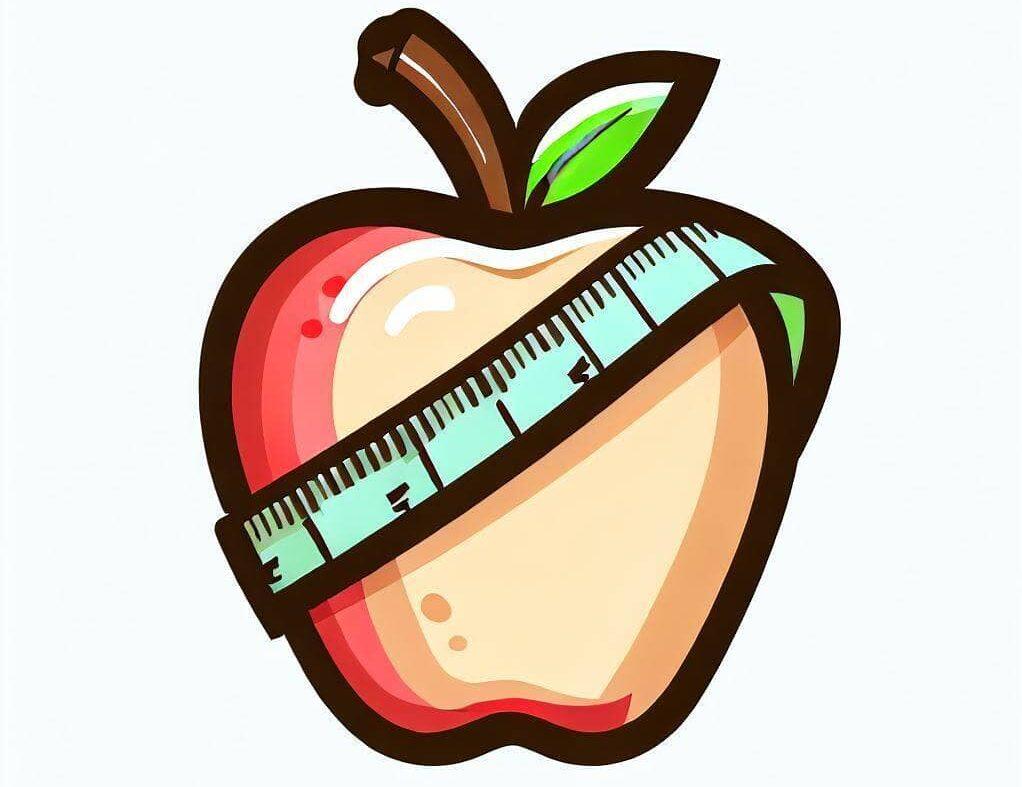Why Sugar is Bad For Weight Loss? (And More)
This post may contain affiliate links which means I may receive a commission for purchases made through links at no extra cost to you. See my disclosure policy for more information.
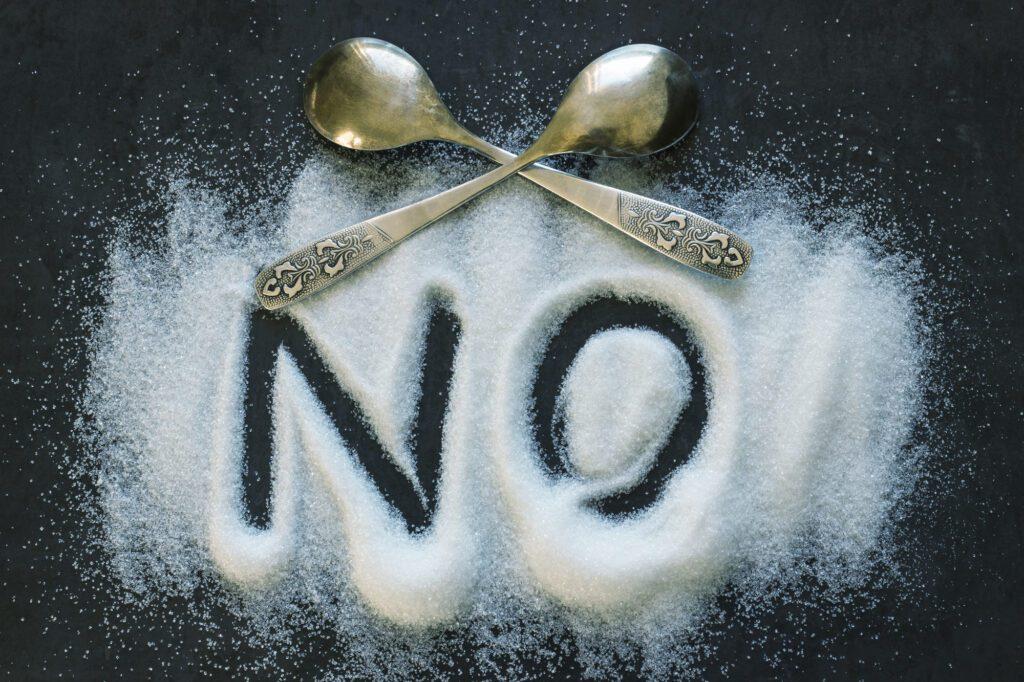
At least once in your life, you’ve probably heard that you can eat any food as part of a healthy diet, even sugar, but only in small amounts. This is because it all comes down to how many calories you eat.
Most people agree that if you eat more calories than you burn, you’ll gain weight. So, it seems like it doesn’t matter if the calories come from sugar or a salad, as long as you’re not sitting around all day and you burn off those extra calories by moving more.
However, even though you need to eat fewer calories than you use to lose weight, it’s not right to say all calories are the same.
The kind of food you eat matters too. Calories from different foods are used differently by our bodies. Some foods are better for losing weight than others.
For example, if you drink a sweet drink with 50 calories or eat a salad with 50 calories, your body reacts in very different ways.
What’s important to understand is that our bodies have different reactions to different foods. This is especially true for sugar. You can’t just think of sugar calories the same way as other calories without thinking about what they do to your body.
In this article, I’m going to explain why sugar is not good for losing weight and also why it’s generally not good for your health.
1. Excess Sugar Intake Can Lead To Accumulation of Liver Fat (Hence Weight Gain)

Table sugar, which people all over the world eat a lot of, comes from plants like sugar cane, beets, or corn. After they take the sugar out of these plants, what’s left is refined sugar. This kind of sugar is half glucose and half fructose.
The American Heart Association has said that women should try to eat no more than 6 teaspoons of sugar a day, and men should try no more than 9 teaspoons.
The reason it’s bad to eat more sugar than this, especially if you’re trying to lose weight, is because your body needs to burn off this sugar for energy.
Glucose is a type of sugar that every cell in our body can use right away to make energy. We get glucose from the foods we eat, and our body turns it into energy that our cells can use.
But fructose is different. Our body’s cells can’t use fructose for energy. Only the liver can deal with fructose. And remember, table sugar is made of both glucose and fructose.
When we eat too much fructose, it’s too much for the liver to handle, and the liver’s energy-making parts, called mitochondria, get overwhelmed. So, the liver has to turn this extra fructose into fat.
This means that even if you’re eating foods that aren’t high in fat if your diet has a lot of sugar, it’s like you’re eating a high-fat diet. That’s because a lot of the sugar ends up being stored as fat in the liver, which can lead to weight gain over time.
2. Sugar Can Create Addiction
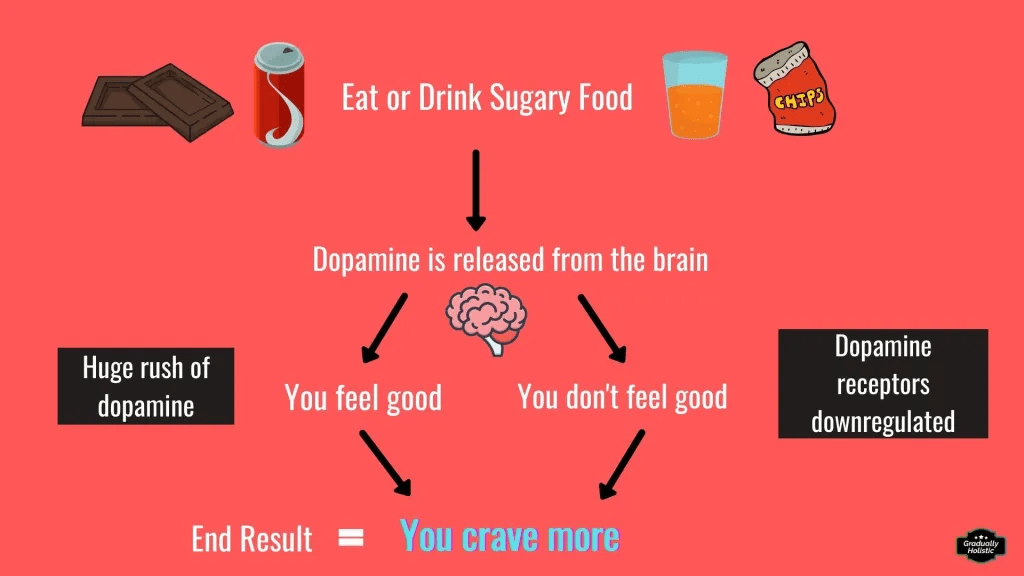
Whenever you eat or drink something that is high in sugar, your body produces a hormone called Dopamine, which is an excitatory neurotransmitter.
Dopamine is a chemical that is responsible for inducing feelings of pleasure in a person. Dopamine is also released during activities like sex.
Whatever your brain perceives as pleasures dopamine will be released during that activity.
The problem with this is that chronic stimulation of dopamine can also lead to addiction, the reason being, that the more dopamine is released the more it downregulates its receptor.
This means when you keep on indulging in an addictive activity such as watching pornography, gambling, social media scrolling, shopping, chronic alcohol and sugar consumption all eventually lead to addiction.
The reason is that the more you indulge in hedonic activities, the more dopamine you release and the more you have to do that particular activity next time to get that same amount of excitatory response from dopamine because the receptors get downregulated over time leading to addiction.
Studies have shown that sugar causes a big rush of dopamine in your brain, giving you that addictive feeling of wanting more the next time.
For example let’s say you have a glass of sweetened soda or a fruit juice, the sugar (fructose) in them lights up the limbic system in your brain, stimulating dopamine and leading to addiction over time, making you crave more again and again.
This cycle can be a big problem when you’re trying to lose weight. The more sweets you eat, the more you want them, making it hard to stick to healthier food choices. This can lead to eating too much and choosing foods that aren’t good for weight loss.
Also Read: What Role Do Hormones Play In Weight Loss?
3. Sugar Consumption Can Lead to Metabolic Syndrome
In a nutshell, metabolic syndrome means a number of risk factors for different types of diseases, like type 2 diabetes, hypertension, cardiovascular disease, etc.
How does sugar play a role in this? As stated above, when sugar (fructose) is consumed in excess, it is converted into liver fat which leads to insulin resistance in the liver.
Insulin is the hormone responsible for glucose regulation. Whenever you eat a meal, your blood glucose level goes up, insulin is released from the pancreas and it stores that glucose in the blood in all the cells of the body.
Although, When insulin resistance occurs in the liver it means the cells of the liver are no longer responding to the usual amount of insulin to store that blood glucose.
Hence the pancreas has to work harder by releasing even more insulin every time you have a meal leading to type 2 diabetes and fat storage around your organs commonly referred to as belly fat.
One of the waste products that is produced from excess sugar (fructose) consumption is uric acid.
Uric acid is the reason for diseases such as gout. One of the other damaging aspects of uric acid is that it blocks nitric oxide production in the blood vessels which is responsible for vasodilation (unrestricted blood flood).
Thus leading to constriction in the blood vessels and increasing chances of hypertension.
4. Sugar and Alcohol Cause Similar Damage to the Body
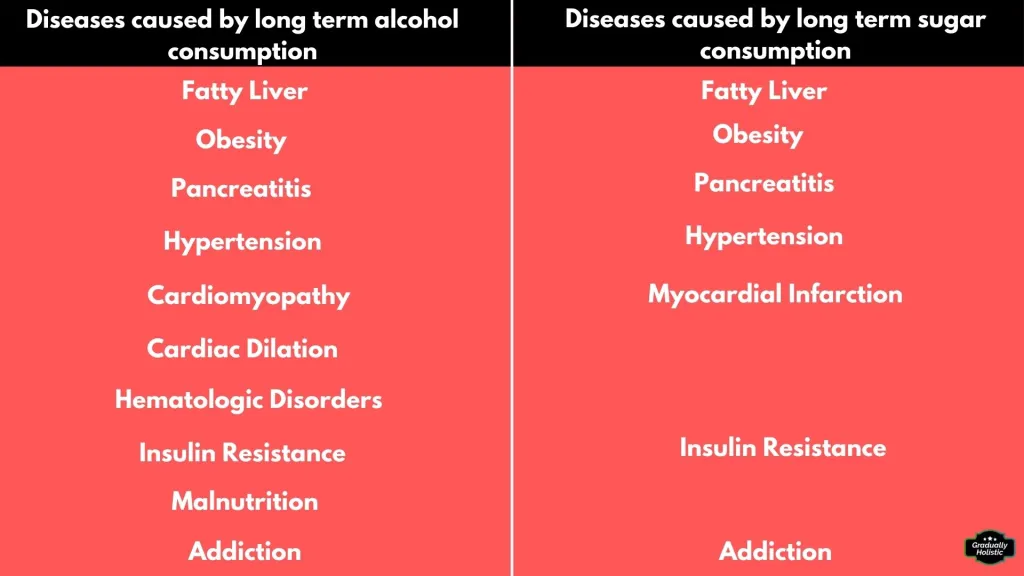
What does alcohol have to do with sugar since they are both quite different and cannot be compared right? Well, not quite.
Ethanol is the active chemical ingredient found in alcohol. Ethanol is naturally made when the sugar is fermented by yeast.
Chronic alcohol consumption causes a disease known as fatty liver. Why does this happen? Similar to sugar (fructose), the cells in your body cannot directly use alcohol for energy.
Hence the job rests on the liver to metabolize 80% of the alcohol consumed. And what is the result of it? the liver gets overwhelmed and it turns the ethanol into liver fat causing fatty liver.
The only difference between sugar (fructose) and alcohol is that you dont get the same intoxicating effects from sugar as one gets from consuming alcohol since the brain does not metabolize fructose.
Sugar also causes a disease known as NAFLD (non-alcoholic fatty liver disease). More and more children are now being diagnosed with NAFLD due to their excess sugar (fructose) consumption.
Fatty liver also increases the risk of cardiovascular diseases because when the liver turns the fructose into liver fat, it also converts some of the fructose into LDL (low-density lipoprotein) to get stored in your muscle and fat cells.
There are two types of LDL, particle A, and particle B, LDL A is reportedly neutral in its morphology it is not as dense as compared to LDL B and does not increase the risk of a cardiovascular event (heart attack).
LDL B on the other hand has shown to be the trouble maker, because it is dense in its chemical structure and sticks onto the endothelial cells in the blood vessels leading to plaque formation causing atherosclerosis (narrowing of the blood vessels) leading to heart attacks, stroke, kidney disease etc.
Lastly, sugar (fructose) can harm your liver and cause the same diseases as done by alcohol.
5. Sugar Can Accelerate the Aging Process
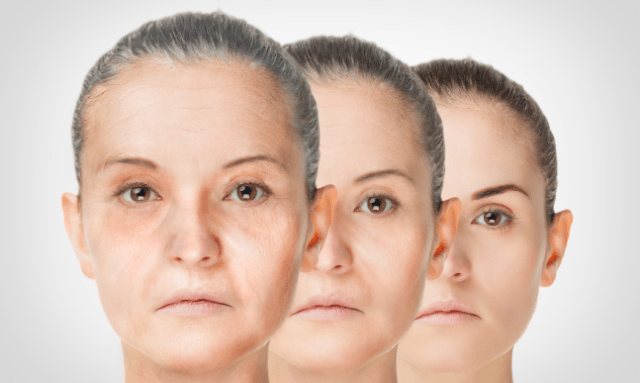
There are enough studies out there linking excess sugar consumption and accelerated aging.
The reason is that the sugar from the food we eat binds to hemoglobin in the blood known as glycation which causes something called the maillard or browning reaction.
It’s the same reaction used to brown the meat using barbecue sauce except it’s heated over 300 degrees.
Our body’s temperature is usually 98.7 degrees therefore in a normal scenario it takes several decades for aging to occur through glycation.
However, studies show that the fructose in sugar drives the Maillard reaction seven times faster than glucose.
This small difference can cause the cells in your body to age more rapidly than they should leading to accelerated aging, wrinkles, cognitive decline, etc.
6. Sugar is Virtually Found in Every Processed Food
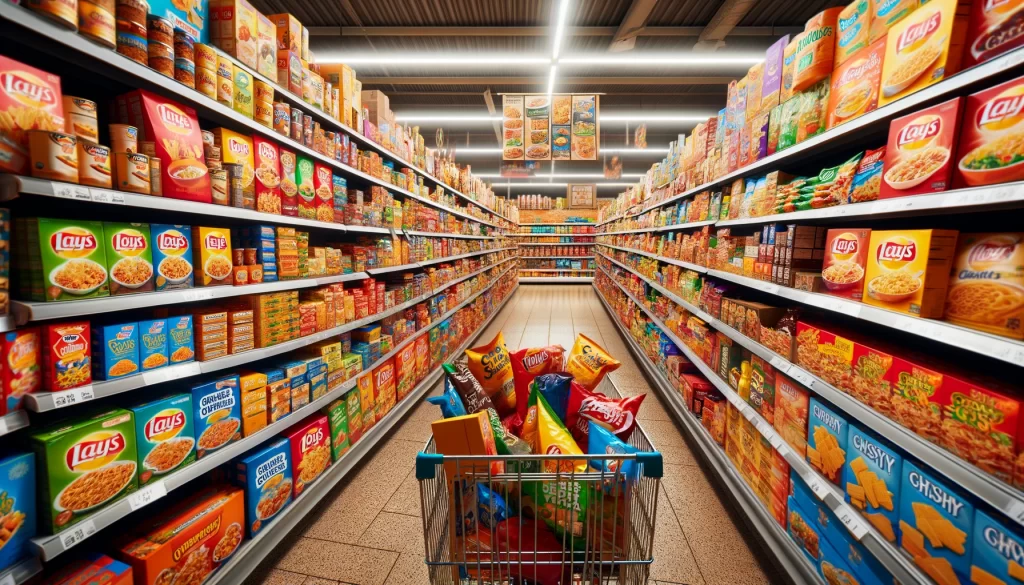
Go into your kitchen, and pick up any food item that came in a package. Read the nutrition label behind it and in most cases, you will find sugar in the first three ingredients.
It’s found in every processed product, whether it’s bread, flavored yogurt, chips, tomato sauce, soy sauce, you name it and most possibly it will be there in one of the listed ingredients.
The question is why? why is there added sugar in so many packaged foods nowadays? the answer is as I mentioned above, sugar (fructose) is addictive especially when you combine sugar, salt, and fat you get a delicious and addictive combination that you can’t get enough of.
The food industry is indeed aware of this fact hence you will find sugar in 90% of the items in your grocery store. They know if they put it in there you will come back for more and that has been the case.
Tips to Reduce The Negative Effects Of Sugar For Weight Loss
1. Eat Your Sugar with Fiber
By “eat your sugar” I mean naturally available sugar like fructose which is found in fruits along with fiber. If fructose is poison, fiber is its antidote.
When you drink sweetened sodas, fruit juices, and smoothies, they are stripped of their fibrous content leaving only the sugar behind which overloads the liver.
Fiber slows down the absorption of sugar in your intestine, which allows your liver to not get overloaded by it and function properly.
Fiber also feeds the good bacteria in the large intestine which maintains a healthy gut and limits any ill effects of fructose.
Therefore keep your consumption of sweetened sodas, fruit juices, and chocolate to the absolute minimum and eat your fruit rather than juicing it.
Also Read: Is Kombucha Good For Weight Loss?
2. Increase Muscle Mass Through Exercise.
Exercise is really useful, but not for the reason you might think. It’s not just about burning off the calories from junk food because our bodies don’t really work like that.
What exercise does is increase the number of mitochondria, which are like tiny energy factories inside our cells.
This happens because exercise helps you build more muscle, and having more muscle means your body burns more energy, even when you’re not doing anything.
So, even when you decide to indulge in a sugary treat, because you’ve built up muscles, those muscle cells can use it for energy.
This is in contrast to someone who is sedentary or has less muscle mass, where consuming a dessert or a sugary drink like bubble tea would more likely result in it being stored as fat.
This is a big reason why exercise is so good for helping you lose weight not because it burns calories when you exercise (it does), but its about the long term benefits which comes with muscle mass.
This actually helps you burn more calories every day. So, let’s say you usually need to eat 1600 calories to stay at your current weight, which we’ll say is 70 kg.
Normally, to lose weight, you’d aim to eat less, like around 1400 calories, keeping all your food within this calorie limit.
But, if you start exercising and build up a good amount of muscle, the number of calories your body needs just to keep those muscles might go up to, for example, 1700 calories a day.
This change means you can have a bit more freedom with your diet. You can enjoy some sugary treats now and then and still be on the right path to hit your weight loss targets.
This works because your body can burn off the extra sugar more efficiently due to your increased muscle mass.
Also Read: Is Recumbent Bike Good For Weight Loss?
3. Change Your Relationship With Sugar
If you have a “sweet tooth” for desserts, start thinking of them as something that is only eaten at special occasions like weddings, birthdays, etc i.e. once in a while.
If you still crave something sweet everyday substitute for real and whole foods like fruits, smoothie bowls, or unflavored yogurt mixed with fresh fruits.
Replace low-fat and flavored milk with full-fat milk (Unprocessed milk) – Similarly replace any flavored yogurt with normal yogurt without any added sugar.
Get into the habit of reading labels while buying anything in your grocery store to seek out any hidden added sugars.
Avoid or limit using any bottled sauces or make your own. Tomato ketchup, mayonnaise, or any barbecue sauce are usually loaded with sugars. Replace them with homemade chutneys or yogurt dips.
Also Read: Is Intermittent Fasting Good For Weight Loss?
Bottomline
Even though I advocate everything can be eaten in moderation. I believe the consumption of sugar and any processed food should be kept to the absolute minimum.
The goal should be to eat within the realm of real and wholesome foods such as fruits, yogurt, green leafy veggies, whole grains, etc.
Finally, Never buy your groceries while being hungry, you will most likely end up buying things that give you instant gratification – meaning processed food.
If you are someone who is having a hard time staying off processed food. While grocery shopping stick to the edges of the grocery stores, where you will find fresh produce, and avoid the middle aisles since that’s where most of the processed food is stacked, that way you give yourself less chance of being tempted by anything sugary.
This post may contain affiliate links which means I may receive a commission for purchases made through links at no extra cost to you. See my disclosure policy for more information.
Rahul is a professional nutritionist certified by the International Sports Sciences Association (ISSA) and a personal trainer certified through the American Council of Exercise (ACE). He has a special interest in the science of nutrition and how it can impact the body.
